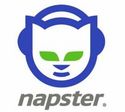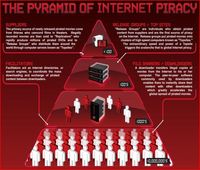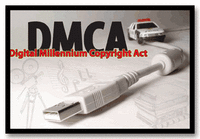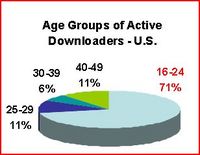Group 1: Catherine Pham, Yoosung Choi, Richie Nguyen, Nam Hoang
Contents
Piracy
Introduction
Group Members: Catherine Pham, Yoosung Choi, Nam Hoang, Richie Nguyen
Topic:Piracy and How It Works
History
Copyright gives the owner or creator exclusive rights to the work in publication, and distribution. Without permission of the owner it would be considered theft if someone were to distribute it. Copyright infringement laws were implemented to protect the creator's work. Although in this world there are always people trying to steal and take rights of a work from the creator; some are caught but most get away with it. Digital Piracy is a prime example of copyright infringement.
Piracy and copyright infringement always existed, but digital piracy had started to become popular in the late 20th century. In the early 1970s a group of elite hackers and programmers called themselves "The Scene". The Scene was an online community that hacked and cracked software, they emerged onto the internet by a Bulletin Board System (BBS), and from there they could share methods and strategies with one another. Members of The Scene would compete against each other on who could crack the latest software, this was not done for profit but it was done for a title and rank of technological superiority. BBS was also the beginning of "1337 Speak" where users would replace letters for numbers and symbols because speaking of topics like hacking and cracking were illegal. Movie and music piracy was also very similar to software piracy. It would usually begin with a person or group of persons buying or stealing a cassette/CD/VHS/filmstrip and redistributing them by making copies and secretly selling them or sharing them.Digital Piracy had its flaws along with any other scheme, their problem was internet. Dial up internet was used during this time; it was very slow and costly. Internet access was often restricted to its own region unless the user wanted to pay for long distance phone charges, many didn’t want that due to high long distance rates. However most hackers and programmers would work their way around the long distance charges by tricking the system that they weren't using any long distance. It wasn’t until when faster internet that did not use the phone line surfaced made digital piracy very easy.Piracy today has changed laws from all over the world, one of the first major piracy busts was Napster. Napster was a P2P program where users could share and exchange music online. Napster was an important landmark in the piracy scene because it had influenced other programmers to create software that are more effective and that could transfer files other than MP3's across the internet. Due to lawsuits from the MIAA Napster had been shut down in July of 2001, and in September 2001 Napster had to pay music creators and copyright owners $26 million in lost money due to copyright infringement.
Distribution
From the 70s and 80s there was always a need for distribution of pirated material. Although during those times distribution was seemed very ineffective because they had to physically deliver or mail that material that was stored on cassette tapes, VHS tapes, floppy disks, or CD's.
Nowadays with faster internet, transferring files have become much easier to do and obtaining pirated material has become almost effortless. Pirated material is obtained by Releasegroups, which is then released to Topsites, FXP boards, then to IRC, then to Newsgroups, then to Peer-2-Peer and then finally down to physical hard copies.Releasegroups
Releasegroups a group are people who would go and physically steal from the creators. They are usually a small group of people that although may not know each other in real life, but work together to steal goods. Releasegroups often communicate through IRC channels through very highly encrypted and secure networks. Trust is a very important issue at this level because anything can go wrong and if one member gets caught, the other members in the group will have a chance of being caught as well. With any group there needs to be a well planned structure, Releasegroups are usually ran by a leader who decides on which strategies and route the group should take, the leader also needs to keep peace between members in case if something goes wrong. A release group always needs a supplier; the supplier has access to material such as music, movies, software, and e-books. They are the source to obtaining material for distribution which are then given to crackers and or encoders, these are the people who prepare the files so that anyone can use them. The files are then ready for distribution, couriers will release the files over FTP’s which are often accessed by Topsites.
Topsites
Topsites receive their files from Releaesgroups from FTP servers; Topsites could also be called the couriers from Relasegroups. The purpose of a Topsite is to release files as much as they can onto other websites. Topsites upload their files onto highspeed FTP servers that can store maximum memory on their server, the speed a Topsite is around 15MB/s. Topsites like Relasegroups also has a structure, this structure consists of 2-5 Site-Operators, and Racers. Site-Operators are people who manage the Topsite, it consists of a supplier (ex: courier from a Releasegroup), a Nuker (a person who “nukes” meaning that they get rid of old or fake files). Racers people who will release to FXP, they are called racers because they race to share files to the FXP so they can have more downloading credits, race is usually started just after the Topsite receives files from the releasegroups.
FXP Boards
FXP Boards is a method where files are transferred between two FTP servers, it works as a sever to server rather than the popular Peer2Peer. An FXP board is a community where advanced hackers form a process to distribute illegal material. Different groups are assigned different tasks; one group would scan and look for vulnerable computers that have fast internet connection for the hackers to hack into. The hackers would then hack into the computers and install a rootkit and make a login account on the computer or giving out the IP address giving access to other groups to do their work on. Next up is a group that will put illegal files onto the computers that have been hacked, once the files are on the computers a download link is posted on the board for others to download. Like the Racers in Topsites, it is always a race on who can get the release out the quickest for more downloading credits.
IRC Trading and Newsgroups
IRC is an online chat system where users interact with one another. IRC trading is direct user to user trading where one user can share a file to another person directly from their computer (ex: sharing a file over Instant Messaging), another way to share files on IRC is from a server to client connection, people connect to the server to download the latest releases, downloads are often fast but are limited.
Newsgroups is a system very similar to the old BBS system, Newsgroups store messages and files that users post. It provides a direct way for more people to access the pirated material.
Peer-2-Peer (P2P)
Perhaps the most common way for anyone to download pirated material, P2P is at the bottom of the piracy chain where all files are easily accessed but it is the least secure making the user vulnerable to investigations by groups like the FBI, the RIAA, and the MPAA. Peer2Peer is users sharing between one another usually in a sequential order from one other client at a time. P2P is basically a giant Ad-Hoc network where P2P programs like Limewire, Bearshare, and Bittorrent connects the users together to share files. BitTorrent is possibly the most popular way for sharing files on a P2P level. P2P is only effective if there is an uploader, if no one uploads then there are no files to download.
BitTorrent
A P2P Program that was created and released by Bram Cohen in 2001, the program was designed to take multiple users and sources to copy the pirated material for the downloader. This was a much more effective way for P2P using multiple sources made downloads much quicker. Unlike some P2P programs like Limewire where you can type anything into the search query that is implemented into the program, for bit torrent the user has to go online and look for torrents to download. And the user requires having a bit torrent client in order to download. BitTorrent is one of the more effective ways for users that aren’t connected into the piracy scene to download.
Crime
Evidence of the link between piracy and organize crime became apparent in the late 90s as it got easier to make a profit in the illegal trade. They have been numerous arrest of gangs who deal not only with drugs but the also the distribution of illegal copy. The gangs have gotten to this business because it has become so easy to duplicate movies, software, music, and books, that it's almost impossible to stop. The profit margin are huge, the cost of entry is minimal, and the risks are relatively low, especially in countries that don't have laws that helps prevent piracy. In some cases, people that are smuggled illegally are force to sell counterfeit goods in order to pay off the travel fees.
In sheer volume, China is the largest market in the world for counterfeiting. Organize crime in China has a long history and is frequently associate with corrupt official in government and the military. This makes it hard to pass a law that would help stop piracy because the Chinese triads have so much influence. Hong Kong especially been a big shopping destination for counterfeit items of all types. The arrival of DVD resulted in an explosion of high-quality piracy in the late 90s. This digital revolution help pushed cash strapped consumers to turn more readily to cheap counterfeits.
Laws
US
In comparison with other countries, the U.S. has very strict intellectual property laws. The Digital Millenium Copyright Act (DMCA) signed in 1998. It was established in order to balance between the rights of copyright owners, and the needs of people using copyrighted works. Under this law, “No person shall circumvent a technological measure that effectively controls access to a work protected under this title”. Under certain conditions, there are exemptions provided. Those exempted (under certain conditions) include nonprofit library, archive and educational institutions, reverse engineering, encryption research, the protection of minors, personal privacy, and lastly, security testing.While the anti-circumvention clause of DMCA was meant to protect the rights of copyright owners, it also has its costs. Many argue that DMCA prevents free expression and scientific research, jeopardizes fair use, hinders investment, competition and innovation, and obstructs computer intrusion laws.
Penalties for violation of DMCA consists of a 10-year prison term and/or fines of up to $500 000. There had also been proposals pushing for the fines to increase to $1 million.
Canada
Canadian laws allow downloading for personal use to be legal while uploading is considered illegal. Unlike the DMCA, Canada’s copyright laws do not contain a clause that makes circumvention, and tools used for circumventing digital copy protection mechanisms. However, under Canadian laws, only certain types of media are authorized to be copied for personal use. This includes audio tapes, CDs, and MP3 players. DVDs are still prohibited from being copied.
In 2008, the government introduced Bill C-61 that allows customers to copy media such as books, television, and radio programs. However, the bill also contains an anti-circumvention clause that prohibits breaking of digital locks from copyright material.
The penalties of breaking copyright laws in Canada include up to $1 million in fines, and/or a maximum five years in prison.
Strategies
Permissive stance to piracy: This strategy might only work well in the short run. For example, in the case of music piracy, in the short run it is good for exposure; however, in the long run, if piracy continues, it will result in loss of revenues.
Give out free samples: This strategy can allow customers to test the product before they buy. For example, book publishers already provide excerpts for many popular books, and the success of this is reflected in the fact that the case of book piracy is not as prevalent as music piracy. The record company can use this strategy by offering 30-second clips of songs, or songs that can only be played a limited number of times.
Reduce pricing: The main reason from people who practice in illegal downloading is that the price of media is too high. People choose to pirate media since the cost of piracy is less than the cost of the media. Therefore, companies should consider reducing prices such that the customers will be more willing to pay rather than pirate. For example, companies can adopt a pay-what-you-value policy. According to economic theory, by having customers pay based on their reservation price, there will be no dead-weight loss. The success of this strategy can be seen in the music industry. In particular, the band Radiohead chose to have customers pay based on this strategy and enjoyed a large success not just in sales, but profits. However, this strategy is not always feasible, especially for un-established artists.
Offer extras for legal purchase: This strategy makes it more attractive for customers to buy legally. For example, textbook companies can include things such as online supplementary material, record companies can offer posters, software companies can offer free technical service, and film studios can offer extra bonus disks with deleted scenes and commentary.
Change business model to one less vulnerable: companies can move from selling discrete products to ongoing service for a subscription. For example, software companies can sell customers products at a low price, and then have the customer sign up for a subscription in order to have continuous updates.
Accept the piracy technology: Companies should recognize that piracy will continue to exist regardless of their strategies. As a result of this, companies can offer legal alternatives. For example, the music industry has online music stores where customers can buy singles, the film industry offers customers to buy videos online, have it mailed to them, and/or have it streamed from a device to their televisions. And the television industry has offered television shows to be streamed directly from their websites hours after airing on television.
Increase the perceived moral intensity: People are less likely to pirate if others are not doing it. Therefore, if public perception of piracy is seen as reprehensible, people are less likely to act on it.
DRM: Companies can employ the use of Digital Rights Management (DRM) into their products in order to protect and manage intellectual property, and to prevent illegal distribution and use. The main technologies that can be used for DRM include the use of encryptions, passwords, watermarking, digital signatures, digital fingerprints, copy detection systems, and payment systems.
Film Piracy
Movie Piracy was consider impossible by major studios back when dial up was common. The movie distribution tends to be small because the technique to make the file smaller was to compress it. This would lower the video quality which was not popular with the public. With the rise of broadband however, higher quality films had started to see widespread distribution. This has become a major concern amongst the major studios. The MPAA has run campaigns during movie trailers to discourage movie pirating. Only recently has the movie industry move to a legit online distribution with the launch of Amazon Unbox.The MPAA has conduct some major studies to educate others. It claims that major United States motion picture studio has lost 6.1 billion dollars in 2005 due to worldwide piracy. That 80% of those losses came from oversea piracy while 20% came from the United State itself. Also 62% are the result of hard copy goods like DVDs while 38% came from internet piracy. The MPAA says piracy rates are highest in China, Russia, and Thailand. The age of a typical pirate is age 16-24 and male.
Movies were usually release in several formats and different versions due to the fact that different groups use different technique to get a copy. Pirated movies are mostly release by groups called "scene" or "warez groups". The first release of a movie is usually low quality and eventually being replace by better quality releases.
A famous example of movie piracy is the release of "American Pie" by EViL. It was release in a uncensored workprint format. The theatrical release was cut down to avoid nudity in order to pass the MPAA guidelines. It was also release 2 months before its theatrical release. It was also one of the reason the movie company release a unrated DVD edition.
In October of 1999, a program called DeCSS was released. This program removes the CSS encryption on a DVD, which meant one could decode the content for ripping. This combined with DivX greatly increased video quality. Early DivX releases were quickly become the standard codec and became the most widely used format. With the help of associates from movie studios, theaters, or video rental, new releases were appearing at a very fast pace. DivX would soon go commercial with their version 4.0 and a new free codec was needed. That was when XviD came in and as of today, it has almost entirely replace DivX.
Film Piracy Methods
Camcordors
Camcordors were early attempt of pirating films by using the camcordor to tape the on-screen projection. To stablize the cam, it was mounted on a tripod. The sound was recorded from the cam's built in microphone. The quality range from terrible to very good depending on the the group doing the recording and how good was the camcordor. The main disadvantage of the camcordors was the sound quailty because it was recorded using the microphone. Not only was it bad quality but it also made it possible to hear the audience in the theater. The camcordor can also record people walking around in the theater. A advantage with using a cam was how quickly it can pirate movie. It can pirate movies that were in their theatical period.
Telesync
Telesync's video quailty is usually the same as the camcordor but its sound quality is much better. The reason for this is because usually Telesync has a direct connection to the sound source. Other possible ways include recording a movie using a professional microphone in a empty cinema or record the sound from the FM radio transmission used for the hearing impaired customers.
Workprint
Workprints is an unfinish(rough copy) version of a movie. Usually, workprints differ from their theatical release. A famous example is the "X-Men Origins: Wolverine" movie. It was release a month before it theatical release and was not finish.
Screener
A screener is a DVD copy of a film sent to critics, award voters, video stores, and other film industry professionals. Often, each individual screener is sent out with a distinct mark, which can be use to track down in case if copies are made. This helps the movie studio track down where the source came from. Usually the movie quailty is a bit lower quality than DVD Rip.
Telecine
Telecine is a less common form of pirated copy of films using a telecine machine which are very expensive. This requires a print of the movie on film, which cannot be obtain legally. with it requiring expensive equipment and because its illegal to get a print, it's very uncommon.
R5
R5 uses telecine machines but they are used by the studio themselves. The studio will use the equipment to get it from the original source. The purpose is to make a high quality copy and is released before the digital post-processing. This format lets the studio combat against DVD screeners.
DVD Rip
A final retail version of the film, usually release before it is available outside of the source. This is high quality so DVD rips usually replaces any old copies.
BD/BR Rip
Similar to DVD Rip but from a bluray disc.
HDTV or DS Rip
TVrip is a capture source from an analog capture card. DSR is a rip captured from a non standard definition digital source (satellite). HDTV or PDTV rips often come from over-the-air transmission. HDTV source can usually pass DVD. This is the most common way pirated films are now made.
E-Book Piracy
E-books can be considered as computer and digital representations of physical books. They consist of scanned pages or re-flowable text streams reconstructed by software in order to mimic real pages.
Electronic books can be used for a variety of reasons. They can be used for things such as databases (e.g., online encyclopedias and online dictionaries), learning objects to enhance textbook content, viewable sources (e.g., digital libraries), and narratives (substitute for physical books).The implementation of electronic books is still in its early stages of development; however, it has thus far proven to be a very successful venture. In particular, academic and educational institutions widely adopt the use of electronic books to improve operations and increase student learning experience.
Still in its infancy, the use of electronic books still has challenges that need to be overcome. Specifically, formats have showed to be a very large issue. This issue pertains to whether consumers should be locked into a single model or if they should be given options with regards to device, format, retailer, and content. In addition to this, the problem of Digital Rights Management (DRM) is a hotly contested issue. DRM is a technology that is embedded into files. It allows companies to control how copies of their material can be made, and which devices can use them. Some argue for the use of DRM and lock-ins of devices, while others to use DRM to protect against piracy, finally, there are some people against DRM and want open access to content.
There are a variety of problems associated with DRM and electronic books. Unlike physical books, with electronic books, consumers are not able to easily transport their books. Because of DRM that is embedded into files, even if a consumer purchased a book for his or her electronic reader, it would not be possible for that consumer to transfer that file onto their computer. In addition to this, unlike traditional books, consumers would not be able to resell the e-book once they have finished reading. Not only are e-books difficult to transfer because DRM prevents them from being copied to other devices, consumers who purchased e-books can also be prohibited from reading their books if the books they purchased is not compatible with their reading device. Amazon has curtailed this problem by allowing their consumers to email and convert books that they purchased for a small fee. As the music and film industry has witnessed, embedding DRM into media is not a good operating strategy. This is evident in the buying habits of consumers who have decreased their purchases due to this restrictive technology. Thus, the book industry should find other methods to adopt that still protects its product, but concurrently does not restrict the consumers.
Since electronic books are still considered to be new, there are still those who believe that printed books will always be the more popular option. Many famous companies are expanding their operations via the e-book route. For example, Google plans to make electronic copies of all books available within ten years. Amazon is also selling books in digital formats to be read with its Kindle electronic book reader. However, not everyone is in support of these endeavors. Some worry that while the digitalization of books can broaden audiences that were previously untapped, it can also cut into revenues.
Competitors such as Sony and iRex are doing well and comparable to Amazon, this protects customers from the pricing power that Amazon could have if it were to hold hegemony electronic book market. Unlike Apple’s introduction of the iPod and iTunes, Amazon’s Kindle and e-book store will not change the landscape of books like Apple did to music. It will be a very long time before the majority of people completely switch over from the traditional format of books to electronic format. This is due in part to attitudes and the weariness of people to commit to technology that is still in its early development.
Music Piracy
Music has become one of the most popular items to illegally sell or distribute. This includes uploading a CD and illegally sharing with other people over the internet, or copying the CD and selling a hard copy.
The sales of CD’s have been declining every year because of this, and it is becoming a major problem for the artists who work hard on recording and producing the albums. In places like China, the problem is so severe that the artists face the facts that their CD will be illegally distributed, and uses their album to endorse their image so people will buy their products, and go to see them in concert. In some cases, artists will include bonus features in their album such as a sticker booklet, or anything that you cannot get with an illegal copy, which convinces people to buy their album (or tries to).
According to the International Federation of Phonographic Industry (which tracks music copyright issues worldwide), it stated that 95% of music sales in China are pirated copies. But it’s not just China that is facing this problem. In the United Kingdom, 1,158 kids aged 18-24 in the UK, 95% of them have "pirated" music before according to a University of Hertfordshire survey. This problem is a worldwide issue, and is becoming a growing problem at an alarming rate. It doesn’t help that there are millions of servers such as Limewire, Kazaa and Morpheus which allow people to illegally share not only music, but any other type of file that may be copied. There is a server called Napster that revolutionized the pirating music scene. It was one of the first online servers where people could upload and share music. Artists became angry and started suing Napster. One of the most famous cases was with a rock band called Metallica. Because there were so many lawsuits, Napster decided to charge users for songs so that the artists can be compensated. There are also torrents which are also another P2P (person to person) file, which allows anyone with the access to the internet to illegally share files.
There are numerous kinds of groups that represent the recording industry and try to prevent the illegal sharing and distribution of music. The RIAA (Recording Industry Association of America) is one of the most famous groups. They try and shut down websites which allows people to share music for free, but every time they shut one down, there are at least ten new websites that pop up.
One of the reasons why music is one of the most illegally distributed or sold item is because of the convenience. To copy and upload a CD takes less than five minutes, and because the average size of a song is around 3 MB, it can be transferred from one person to another in a very short amount of time. Another reason is simply because most people believe buying a CD for $15 or more is outrageous. Many people only like a few songs on the album, so to pay for only one or two songs out of however many songs there are in the album, seems like a waste of money.
And lastly, according to an internet survey, more than half the people said that they didn’t think pirating music was hurting the music industry. They believe that the artists make enough money from their endorsements and concerts, and that a few thousand people pirating their album will not make the artists go broke. This is true, although the artists should be compensated for their work. For most artists these days, there needs to be an incentive. If they do not sell enough records, they will stop producing albums. So if a listener wants to keep on listening to his/her favorite artist, they should buy their album to support them. This is where servers such as Myspace and iTunes come to the rescue. Myspace is an internet site where artists can upload a sample of their new album, and it gives the listeners a chance to listen to the album, and if they like it, they can go and buy it. Then there is iTunes, which allows you to preview a song, and buy a select number of songs. So for those people who believe it is a waste to buy an entire CD for one or two songs, this is what they should be doing. Each song on the iTunes store is 99 cents. This is not only cheap, fast and effective, but it also supports your favorite bands and keeps the recording companies and artists in business.
So the next time you download or distribute music, remember that it is stealing and against the law, it betrays the songwriters and recording artists who create it and it stifles the careers of new artists and up-and-coming bands. Here are some startling facts about what can happen to someone if they are caught pirating music:
• The RIAA (Recording Industry Association of America) can sue for as much as $150,000 per song illegally downloaded
• Almost 2000 individuals have been sued by the RIAA for illegally downloading as of March, 2004
• More than 400 individuals have settled, paying fines averaging $3000
• The Department of Justice recently announced the creation of the Intellectual Property Task Force, which examines all aspects of how the DOJ handles intellectual property issues
Software Piracy
Software Piracy Software Piracy is often referred to as Warez, this is the term that the pirates use. Software piracy is when a user shares, downloads, hacks, or distribute software without permission of the creator. There are many reasons for software piracy, reasons range from its ease, or price of the software. When an individual purchases a new program, in the terms of use it states that the user pays for the license to use the program not the software. Majority of piracy happens because software is expensive. An example is for students that need to use some software at school but cannot use them at home because they can’t afford to buy a license to use it. An example of a popular program that is used by many people that is really costly is Adobe Photoshop, which retails for $999US on its website for the extended version. Therefore many people will resort to downloading a pirated version of the program. To buy a program that costs a thousand dollars seems ludicrous but the creators claim that lots of work has been put into creating it and many hours has been spent on it and that the programmers need to be paid for their work. Software piracy is also common with small businesses who can’t afford to buy a certain amount of software that are high in cost already. A way to reduce software piracy is to lower the prices of the software.
There are 2 main methods to pirate a program, reverse engineering and making a keygen. Reverse engineering is analyzing and decompiling the executables looking for its dependencies and specific files to crack the software. Cracking or patching looks in the program and removes the copyright protection, hardware protection, CD check, hardware check, trial demo block, serial number or date checks. Cracks are embedded into the program whereas for patches you can run them after the installation of the program. Patches overwrite some of the programming in the executable. The other method is using a keygen. Keygens are small programs that can generate serial numbers and activation codes so it doesn’t require using a crack or patch which are more common to contain viruses.
There are always groups that try to prevent piracy the major group for software piracy is called the Business Software Alliance (BSA). BSA is a trade group that represents software makers, its main goal is to stop copyright infringement on software, it is supported by funds that are given to them by companies that are under them. Some recognizable names that are under the BSA are Adobe Systems, Apple Inc, Hp, Intel, and Microsoft. BSA claims that the software industry loses $11 billion US each year. An organization that relates to the BSA but for Canada is the Canadian Alliance Against Software Theft.
Pros
To even consider there being a pro for piracy is a false pretense. Piracy is no better than stealing the actual product. So to even mention that there is a pro in stealing, would be implying that stealing is O.K., as long as no one is harmed. In fact the truth is, there are hundreds of people that affected. The people who are affected are the hard working people who help create a product (such as a Microsoft product, or a music album). This would include such workers as testers, programmers, studio engineers, or anyone who help make the product. If the big corporations do not earn enough money, these hard workers will be out of jobs, as the companies will not have enough profit to pay these workers. This not only means hundreds of people will lose their jobs, but if a company does not make a profit, they will not be able to keep on producing their products. Companies form to make a profit, and without any cash flow, there will be little to no incentives on keep making a product. An example of this would be a music artist. If they do not see a profit, they will most likely stop producing albums. This is where a debatable topic comes in. Many people complain that artists already make millions of dollars, and that a few people pirating their product will not harm them. They also believe that the artist should be thankful that so many people would spend their time and listen to their song. This is true, although artists spend millions of dollars creating a music album. They need to hire studio workers, instruments, equipment and food, and in the end, artists do not make much of a profit from their album, but rather their merchandise and concerts. So although they make millions of dollars, there are hundreds of hard workers needed to make a album successful.
There could be one positive side to a free product. Such things like demos of a song or product can help more people learn more about the album or software before spending their hard earned money. Many people download songs or a software online because they are afraid that it might not be worth the money they spend. But if they listen to a song, or try a software and enjoy the product, they can then go and buy it.
The bottom line is, piracy is against the law, and for good reasons. There are little to none pros, and the cons outweigh the pro immensely.
Cons
The first thing to mention is that piracy is against the law, so right off the bat, it is illegal and considered to be stealing. When you take a product that many workers put countless of hours into to create a product and people start getting it for free or a pirated version that is much cheaper, they are not getting the profit they deserve. This means there are a lot less jobs, which in turn means that the economy is affected. The economy will not crash and burn, but the employment rate will be affected. Because so many people are negatively affected, there are heavy laws against piracy. Another con is that if you are caught pirating, or downloading a product illegally, you can be sued, fined, or be sent to jail. Because this issue is becoming more serious, the penalties are becoming heavier, and the fines are getting higher. So if you thought you were saving a few dollars for a CD by downloading it, it could come back and haunt you. As stated as above, you can be sued for as much as $150,000 for a song. Another con is all the viruses and spyware that there are when downloading an illegal copy of a product. Many people who pirate these products infect the product with viruses which can damage your computer, and a spyware means that there are people who track your computer, and can steal personal information, or anything that is on their computer. So there is not only a chance of getting caught and fined or jailed, but also the chance of getting your computer infected with viruses and spyware. Also, on many sites where a person can download illegal copies of a product, they advertise pornography. This means that a ten year old girl looking for the new Hannah Montana CD can be linked into a site, where the site is flooded with pornography.
These are only a few of the thousands of cons out there. The most important thing to note is that piracy is illegal, and if you are caught, you can be heavily fined, and even put in jail. Associations such as the RIAA are keeping their eyes opened for pirates more than ever, and more and more people are being fined for breaking the law. Many people believe that pirating a product is a victimless crime, although it is indeed a crime.
Conclusion
People all around the world illegally download products. As you are reading this, thousands of people are downloading either a movie, T.V. show, an album, games, software, an e-book, or anything electronically available for download. The fact is that piracy is getting worse every year, and it is becoming a growing problem world wide. As one torrent site comes down, it seems like there are ten new sites that rise to take it's place, and P2P programs such as LimeWire are becoming popular with age groups ranging from 12-55.
One of the reasons why piracy rates are so high is simply because how easy and convenient it is. With a click of a button, you are opened to a portal of free products. Anyone with little knowledge with a computer can download hundreds of products. According to a study in the U.K., 95% of teens aging from 12-21 have said they have illegally downloaded a product for free. And from the 95%, around 90% said that they did not believe it was harming anyone. Perhaps instead of punishing people who illegally download a product and try and send a message to the people who illegally download a product, they should educate the people about how piracy is harming, and why it is against the law. Without this knowledge, the already high rates of illegal download will rise to the point where no one will ever buy a product again. By sharing this knowledge, we can reduce these high rates, and pirating may become a less serious issue. Another thing we can do is to make the fines heavier than it already is, or make the jail times longer. With the following new laws, people may become afraid to download more products. It may not completely stop pirating but it could help the prevention of illegal downloading.
They are alternate ways of downloading products. An example of this would be iTunes. They sell a song for $0.99 each, which means that the person can pick the songs from an album, rather than buying the entire CD, because they like one or two songs from an album. For a software, they could have it so that some of the uses of the product are limited, and you get what you pay for. An example of this would be Microsoft Office. Instead of having to buy a product in a bundle, you can just choose to have what you want, such as Word, or Powerpoint, rather than getting the products you don't need like Access, or Outlook.
These are just a few ways to combat piracy. The truth is that piracy will never stop. There will always be people who put out illegal copies of products, so the best we can do is to limit the number of people who download illegal copies. Just remember, piracy is against the law, and if you are caught, you will be penalized.
References
http://www.aboutthescene.com/general/index.html
http://www.beginningwithi.com/tech/piracy.htm
http://www.boingboing.net/2005/05/14/why-writers-should-s.html
http://www.cbc.ca/technology/story/2008/06/12/tech-copyright.html
http://www.cb-cda.gc.ca/decisions/copying-e.html
http://www.cmta.com/brochure.htm
http://www.cs.washington.edu/homes/gribble/papers/mmcn.pdf
http://www.digibarn.com/collections/newsletters/homebrew/V2_01/index.html
http://www.digitalnative.org/wiki/History_and_Overview_of_Piracy
http://www.digitalnative.org/wiki/Solutions_for_Digital_Piracy
http://www.eff.org/wp/unintended-consequences-ten-years-under-dmca
http://entertainment.timesonline.co.uk/tol/arts_and_entertainment/books/article3648813.ece
http://en.wikipedia.org/wiki/Copyright_infringement_of_software
http://en.wikipedia.org/wiki/Digital_Millennium_Copyright_Act
http://en.wikipedia.org/wiki/Digital_rights_management
http://en.wikipedia.org/wiki/File_sharing
http://en.wikipedia.org/wiki/Keygen
http://en.wikipedia.org/wiki/Pirated_movie_release_types
http://en.wikipedia.org/wiki/Topsite_(warez)
http://en.wikipedia.org/wiki/Warez
http://en.wikipedia.org/wiki/Warez_(scene)
http://www.expressindia.com/latest-news/Buying-pirated-DVD-You-could-be-helping-DCompany/431798/
https://www.ifpi.org/content/library/Piracy2000.pdf
http://www.ifpi.com/content/section_news/20080307.html
http://latimesblogs.latimes.com/the_big_picture/2009/03/should-movie-pi.html
http://library.yale.edu/~llicense/ListArchives/0206/msg00052.html
http://www.mpaa.org/USPiracyFactSheet.pdf
http://news.bbc.co.uk/2/hi/technology/5005848.stm
http://news.bbc.co.uk/2/hi/technology/7978853.stm
http://news.cnet.com/2100-1025_3-5121479.html
http://news.cnet.com/8301-13578_3-10196424-38.html
http://news.cnet.com/Calif.-man-pleads-guilty-to-video-piracy/2100-1023_3-870888.html
http://www.nuttersmark.com/consciencecleared.html
http://www.npr.org/templates/story/story.php?storyId=100584020
http://www.npr.org/templates/story/story.php?storyId=102330373
http://ocw.mit.edu/ans7870/21w/21w.731-3/cultureshock/becky_1.htm
http://proquest.umi.com/pqdweb?Did=0000001189692564&Fmt=3&Deli=1&Mtd=l&Idx=4&Sid=13&RQT=309
http://www.rand.org/pubs/monographs/2009/RAND_MG742.pdf
http://torrentfreak.com/australian-mafia-to-sell-dvds-080701/
http://www.vxu.se/msi/utb/exarb/2004/04106.pdf
http://www.usatoday.com/tech/columnist/kevinmaney/2005-05-03-music-piracy-china_x.htm
http://www.usatoday.com/tech/news/computersecurity/2006-05-22-piracy-global_x.htm
https://webdisk.ucalgary.ca/~cppham/public_html/
Research Papers:
Comparing the Usage of Digital Rights Management Systems in the Music, Film, and Print Industry (Retrieved March 31, 2009) https://webdisk.ucalgary.ca/~cppham/public_html/CPSC203/Mar31_Comparing%20the%20Usage%20of%
Digital piracy: Causes, consequences, and strategic responses (Retrieved March 30, 2009)
https://webdisk.ucalgary.ca/~cppham/public_html/CPSC203/Mar30_causes.pdf
Distance Education: Law Attempts To Catch Up With Technology (Retrieved March 31, 2009)
https://webdisk.ucalgary.ca/~cppham/public_html/CPSC203/Mar31_laws.pdf
Ebooks are Not Books (Retrieved March 29, 2009)
https://webdisk.ucalgary.ca/~cppham/public_html/CPSC203/Mar29_Ebooks.pdf
Factors Motivating Software Piracy: A Longitudinal Study (Retrieved March 31, 2009)
https://webdisk.ucalgary.ca/~cppham/public_html/CPSC203/Mar31_motivation.pdf
How Copyright Became Controversial (Retrieved March 30, 2009)
https://webdisk.ucalgary.ca/~cppham/public_html/CPSC203/Mar30_controversy.pdf
All research papers were retrieved from ACM Digital Library (Association for Computing Machinery) via the University of Calgary library







